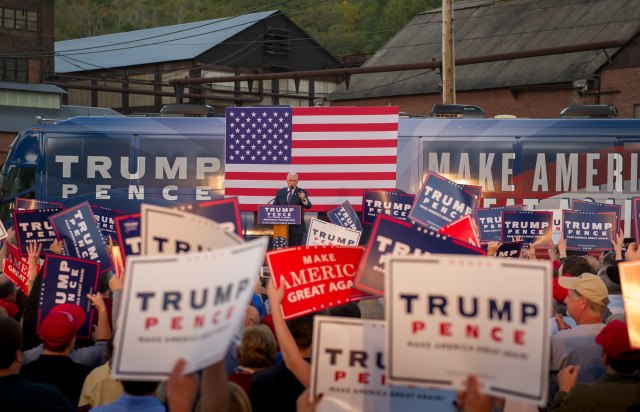Credit: Jeff Swensen/Getty Images

President Trump won, in part, by promising Rust Belt voters their jobs back. In 2016, with manufacturing continuing its long decline, that promise looked foolhardy. Yet two years on, Trump can claim to be fulfilling that promise. The problem is, those jobs aren’t going to the people who put him in the White House.
Contrary to expert opinion, America has been adding hundreds of thousands of manufacturing jobs in the past two years. Last year, the nation’s manufacturers added 284,000 jobs – the most in any year since 1995. That comes on top of the 207,000 additional jobs in 2017, itself a reverse of patterns in the final two years of the Obama Administration.
Trump might not deserve the credit for this, but the timing of the gains strongly suggests he does. Federal government data shows that manufacturing jobs started to increase in December 2016. The gains continued throughout 2017, and accelerated in late 2017 after it became clear that the President’s large corporate tax cuts were likely to pass Congress. Correlation does not prove causation, but it’s hard to imagine what other circumstances were more important to manufacturing’s health than Trump’s election and his agenda.
The problem for Trump, however, is that the Rust Belt is not getting the bulk of those new jobs. Data shows that less than 89,000 of the 503,000 manufacturing jobs gained since November 2016 were in the five Rust belt states whose switch from Obama to Trump decided the election.[1. (Wisconsin; Pennsylvania; Ohio; Michigan; Iowa.] Moreover, the number of jobs varied significantly among these states. The smallest of the five states, Iowa and Wisconsin, obtained nearly half of the new jobs. The largest, Pennsylvania, gained just 7,700 new manufacturing jobs, barely a ripple in the state’s large economy.
The uneven distribution of jobs can also be seen within the Rust Belt states themselves. Ohio, for example, has gained over 21,000 manufacturing jobs since Trump’s victory. Yet the hard-hit Youngstown area, site of many closed steel mills and a region with some of the largest swings towards Trump in 2016, has actually lost 2,100 manufacturing jobs in the past two years.
Michigan, which Trump won by only 11,000 votes, has received nearly 16,000 new manufacturing jobs since he won. But 7,000 of them are in the Grand Rapids and nearby Muskegon regions. Long troubled areas like Flint, meanwhile, are experiencing a continued loss of coveted manufacturing work.
The states really benefiting from the manufacturing upsurge, perhaps not surprisingly, are mainly the same ones which were growing quickly before Trump.[2. See data.] Texas, America’s second largest state, has added over 56,000 manufacturing jobs during the Trump era. The fast-growing Southeast has added another 62,000; while Arizona and Nevada – which have grown rapidly over the past two-plus decades – added more than 30,000. Even tiny Idaho, which is about one ninth the size of Pennsylvania, has added 6,000 manufacturing jobs under Trump – nearly as many as the once-great Keystone State itself.
This gap highlights one of America’s most pressing political challenges: how to ensure that growth is widespread. As in many Western countries, America’s economic growth for the past decade has primarily occurred in large metropolitan areas, and has mainly benefitted people with more advanced education.
Increases in manufacturing jobs are intended to help ‘spread the wealth around’, as they are more often filled by people without college or post-graduate degrees. But if the jobs these people can fill are not going to the places they live, then that’s a problem.
People could, of course, move to fill these jobs, but the evidence suggests that this is not happening quickly enough. Fast-growing Texas, for example, gained a net 467,000 Americans in 2017. Only 35,000 of these, or about 5%, came from the five economically hard-hit Rust Belt states mentioned above. That is far below the 13.3% of the population that the five states comprise.[3. See Table 1]
This strongly suggests that rather than move in search of economic opportunity, many Rust Belt residents are staying put, adding to the political tensions caused by living in towns and areas that are no longer vibrant.
Of course, two years is a very short time in which to change the economic trajectory of a large country. It may be that the significant uptick in manufacturing job growth seen in 2018 will accelerate in the coming years and be more evenly spread throughout the country. That could start to turn around depressed Rust Belt cities, and in the process help Trump’s re-election chances by demonstrating that he could keep promises that national elites thought foolish from the start.
If that does not happen, however, Trump’s re-election chances will likely suffer even if aggregate national growth figures look healthy. The people who put their faith in him may have signed on to a campaign that intended to “Make America Great Again”, but what they really wanted was to make their lives great again. If Trump fails to do that, big job gains in other parts of the country won’t matter to the folk whose dashed dreams are symbolised by the shuttered factory around the corner.










Join the discussion
Join like minded readers that support our journalism by becoming a paid subscriber
To join the discussion in the comments, become a paid subscriber.
Join like minded readers that support our journalism, read unlimited articles and enjoy other subscriber-only benefits.
Subscribe